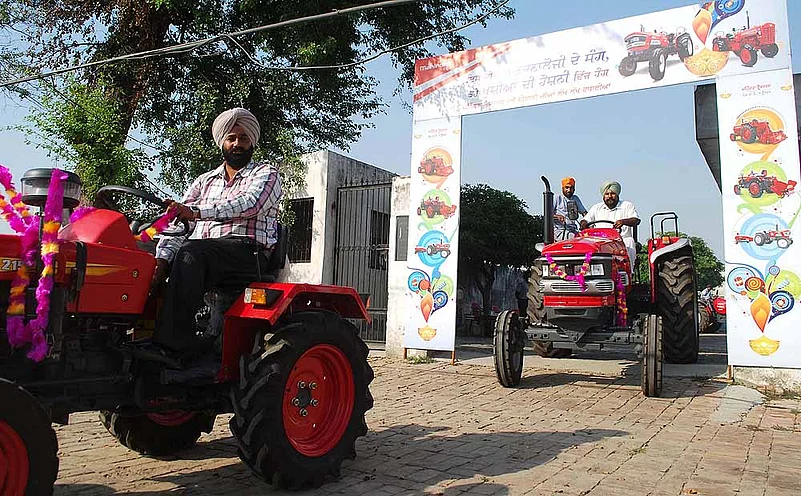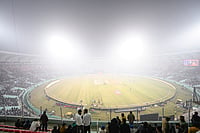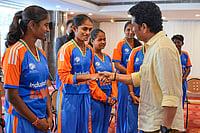Festive Consumption
- After three-four years of not too good sales, Onam in Kerala and Durga Puja in Bengal have seen good sales with some companies reporting double digit growth
- The Diwali season has shrunk to just about a week, squeezing further pick-up in sales
- Northern India is warming up to festivities with expectations that the bumper crop will mean more money in farmers’ hands
- Changing rural landscape with increasing income from services raises demand for electronic goods
- Spoilers could be the new RBI guidelines on credit card finance schemes, account for 30-40% of sales over Rs 10,000
***
He may not look like a typical Indian farmer, but he sure is spending like one; rather, let’s say, like a ultra-modern agriculturist. Bijender Singh Dalal, 49, is among the growing tribe of new-age farmers living in close proximity to towns, who are taking to spiffy new farm technologies like protective cultivation in poly houses in order to grow red and yellow capsicum and tender cucumber. The returns are better from these cash crops unlike the traditional wheat, rice or even cotton grown in his semi-urban village in Palwal, Haryana, 60 km from Delhi.
High on Bijender’s shopping list is a new bike. He’s also looking to buy an air-conditioner while the festive season discounts last. With the approaching wedding of his eldest son, who’s a graphic designer-cum-farmer, gold jewellery, painting and new furnishing for his house are also on the shopping list. Of course, new farm implements and quality seeds to grow broccoli, squash and cherry tomato would also be welcome, thank you. “Things are better this year as I got better price for my produce in the mandi. I will need to borrow money but with a wedding in the family, I am going ahead,” says Bijender.

Bijender Singh Dalal
Electronic gadgets and ACs may sound out of sync with the old image of a village home, but in Bijender’s home and neighbourhood, refrigerators, gas connections and inverters are par for the course. This is the new rural or semi-urban India whose virtues are suddenly being discovered. Consumer goods companies and retail chains are banking on them to drive growth after a good monsoon and reports of a bumper crop in most parts of India, though crops in some parts have been hit by severe weather conditions.
As many as about 30 per cent of people living in rural areas are now engaged in non-farm activities. There has been a 20 per cent increase in wages, which have risen to Rs 300-500 a day near towns. “There is now an organic linkage between urban and rural areas as far as consumer goods are concerned, as many products have become part of the culture due to media exposure,” says Sudhir Panwar of Kisan Jagriti Manch. Many Indian firms are hoping the rural spend will shore up sales and revenues—particularly during this festive season. Special schemes are being designed to woo buyers in rural and semi-urban centres.
For instance, automobile major Maruti, which depends on the season to bring in almost 25 per cent of its annual sales, has a special focus on the rural market. “The bright side in this scenario (when growth is very low) is that the rural market is giving us good numbers. Today, it accounts for 25-27 per cent of our retail sales and we are seeing a 20 per cent growth in this market,” says a Maruti spokesperson.
Similarly, electronics major Philips may seem to aim most products at urban markets, but it sees a good pull from rural markets, even at the tier-3 and tier-4 town levels. Departmental brands, apparel and other retail brands may be the major business generator but Pratap T.P., CMO of online gifting firm QwikCilver Solutions, states that increasing growth is being witnessed in Tier 1, 2 and 3 cities in digital gifting, with more and more brands introducing digital cards.
G.K. Karanth of the Centre for Study of Social Change and Development, Bangalore, attributes the changing patterns in rural lifestyles and spending to the growing number of retail chain stores and impact of globalisation. “The language of globalisation is the vocabulary of consumers today. It has penetrated and not remained on the periphery of villages,” he says.
Not surprisingly, apart from investing in tractors, zero tillage and other modern farm equipment that reduces manual labour, the demand for electronic goods—from the latest cellphone to other gadgets—seems to be growing beyond major cities. A study by KSA Technopak has found that consumers in rural India are in fact not seeking low-priced products, but instead looking for products that are functionally at par, while justifying their affordability. As the income generation is largely dependent on agriculture, consumption is seasonal in rural India, unlike in urban India.
This consumption scenario is, however, changing fast with the government spending crores on rural employment generation and other welfare programmes. “Despite the leakages, these programmes seem to be giving some sort of steroid to rural spending,” says Arvind K. Singhal, chairman, KSA Technopak.
Today, whether it is food, dresses, footwear, spare parts, glasses, mobiles or other gadgets, there is hardly any gap between an urban and rural consumer. “Drastic changes in the last decade have seen technological barriers being broken. Today, every technology and brand becomes simultaneously available all over India. Every family now depends on gadgets for daily utility; as such, they are no longer a status symbol or luxury,” says B.A. Kodandarama Setty, chairman and managing director of Vivek Ltd, the largest electronic goods chain store in Tamil Nadu, with footprints in Bangalore.
Despite “some signs of recession” of late, Setty is banking on several new models in his 51 stores, including many in the small towns, to lure inflation-hit consumers into buying. What is worrying him is the likely impact of the recent Reserve Bank of India directive that the popular zero-interest credit card purchases would have to be transparent on the hidden charges. While the industry average of such EMI sales is around 30-40 per cent for gadgets over Rs 10,000, in Vivek’s case this accounts for about 20-25 per cent sales.
Vivek Sharma, CMO, Philips, echoes the concerns, particularly with regard to “big-ticket electronic products like TVs and refrigerators and mobile phones (which) are bought through financing...today 30-40 per cent of the products are bought through financing and companies come up with more attractive offers during the festive season. Those could be impacted.”
The fear seems genuine, considering the high interest rates of bank loans. There has been expectation in the market that the RBI may come up with some scheme to boost consumer spending and thereby give a boost to the economy. The credit card directive, however, is seen as contrary to the expectations. But Arun Thukral, managing director of credit information company cibil, defends the RBI, saying the directive “is aimed at creating awareness among common people about schemes floated by the companies and banks. Many people want to buy gadgets even when they don’t have the financial capacity to buy. The RBI wants to pre-empt consumers from getting into these EMI offers and thereby falling into a debt trap”.
Going by the trends registered at retail majors, the EMI check is not deterring consumers. Kishore Biyani of Future Group, which includes the Big Bazaar chain, reports strong sales across the consumer durables segment, though the home category is not doing too well, as consumers are not indulging in too much impulse buying. With offers galore, including online, it is happy hunting ground for bargain hunters like Bijender.
The market is happy that Diwali is early this year, as its spending impetus is brought forward, partly offsetting a slow year, countering the inflation squeezing household budgets and economic growth slowing to a decade’s lowest. Large parts of rural India are facing neglect in key areas, but rural consumers are spoiled for choice just now.
By Lola Nayar with Arindam Mukherjee


























